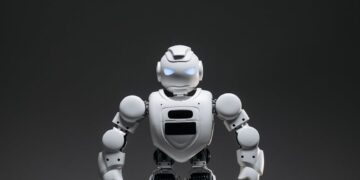<p>The landscape of human-computer interaction is undergoing a profound transformation, driven by the rapid advancements in multimodal artificial intelligence. No longer confined to simple keyboard inputs or touch commands, our devices are evolving into truly conversational partners, capable of understanding and responding to a rich tapestry of human expression. This revolutionary shift, where AI processes information from voice, text, gestures, and even context simultaneously, is fundamentally reshaping how we engage with technology. It promises not just convenience, but an intuitive, seamless integration of digital tools into our daily lives, significantly enhancing our productivity and redefining what it means for technology to truly understand us, right now.</p<
<b>Beyond the screen: natural language and intuitive interfaces</b>
<p>Historically, human-computer interaction has been largely dictated by the machine’s constraints. We learned programming languages, navigated complex graphical user interfaces (GUIs), or adapted to specific touch gestures. Multimodal AI shatters these barriers by allowing us to interact in ways that feel inherently human. It’s no longer about typing precise commands; it’s about speaking naturally, pointing, gesturing, or even having the AI interpret our emotional state from our voice tone. Imagine telling your smart speaker, "Find that recipe for pasta I mentioned last week," and it cross-references your spoken words with your recent browsing history and even your calendar for dinner plans. This convergence of input modalities—audio, visual, textual—creates a holistic understanding of user intent that was previously impossible. This intuitive interaction reduces cognitive load, lowers the barrier to entry for complex tasks, and makes technology accessible to a broader audience, fostering a more natural and less frustrating digital experience.</p>
<b>Enhanced productivity through intelligent assistance</b>
<p>The practical implications of truly conversational AI are most evident in the realm of daily productivity. Rather than mere command-and-response systems, multimodal AI-powered assistants are becoming proactive, context-aware partners. Consider a scenario where you’re on a video call, and the AI automatically transcribes the meeting, identifies action items, and drafts a summary email, ready for your review. Or perhaps you’re working on a document, and you can simply describe the image you need, allowing the AI to generate or locate it based on your verbal cues and the document’s content. This isn’t just about automation; it’s about intelligent augmentation. The AI understands the nuances of your work, anticipating needs and offloading mundane or repetitive tasks. This frees up significant human time and mental bandwidth, allowing individuals to focus on higher-value, creative, and strategic activities. The friction of context switching and manual data input is drastically reduced, leading to a smoother, more efficient workflow across personal and professional domains.</p>
<b>Personalization and proactive capabilities</b>
<p>A core strength of multimodal AI lies in its ability to learn and adapt, leading to unprecedented levels of personalization and proactive assistance. By continuously processing diverse data streams—your spoken queries, your browsing habits, your calendar, even your location data—these systems build a comprehensive model of your preferences, routines, and goals. This deep understanding enables them to move beyond reactive responses to truly anticipate your needs. Imagine an AI that proactively suggests the best route to your next appointment based on real-time traffic, your preferred travel method, and even your habit of grabbing coffee before meetings. Or a smart home system that adjusts lighting and temperature not just based on your explicit commands, but on your typical evening routine and current mood inferred from your voice. This proactive capability transforms devices from tools we command into intelligent companions that actively contribute to our well-being and efficiency, making technology feel less like an external interface and more like an extension of ourselves.</p>
<p>Here’s how multimodal AI enhances common daily tasks:</p>
<table border=”1″>
<tr>
<th>Task</th>
<th>Traditional Interaction</th>
<th>Multimodal AI Interaction</th>
</tr>
<tr>
<td>Scheduling a meeting</td>
<td>Manually opening calendar, finding availability, typing invites.</td>
<td>Voice command: "Schedule a meeting with John and Sarah for next Tuesday to discuss project X." AI checks calendars, sends invites, suggests agenda topics based on project X documents.</td>
</tr>
<tr>
<td>Finding information</td>
<td>Typing keywords into a search engine, sifting through results.</td>
<td>Voice: "Show me that graph from the Q3 report about sales in Europe." AI navigates documents, identifies the specific graph, and displays it, understanding context.</td>
</tr>
<tr>
<td>Managing smart home</td>
<td>Using separate apps for lights, thermostat, security.</td>
<td>Voice/Gesture: "It’s a bit chilly in here, and I’m watching a movie." AI adjusts thermostat, dims lights, closes blinds, based on context and inferred activity.</td>
</tr>
</table>
<b>Bridging the physical and digital divide</b>
<p>The impact of multimodal AI extends far beyond screens, truly bridging the gap between our physical world and the digital realm. Consider augmented reality (AR) devices, where conversational AI can overlay digital information onto our real-world view, responding to our gaze, gestures, and voice. A technician could receive real-time repair instructions superimposed on a complex machine, guided by a conversational AI. In smart environments, from homes to offices, multimodal AI seamlessly integrates, allowing us to control our surroundings with natural speech or subtle movements. This creates ambient intelligence, where our environment understands our needs and responds intuitively. Factories are leveraging these capabilities for predictive maintenance, retail for personalized customer experiences, and healthcare for more intuitive patient monitoring. The promise is a future where technology isn’t something we interact <i>with</i>, but something that intelligently anticipates and adapts to our presence and needs, making our physical surroundings more intelligent, responsive, and ultimately, more productive.</p>
<p>In summary, multimodal AI is not merely an incremental upgrade; it represents a fundamental paradigm shift in human-computer interaction. It has moved us beyond the cumbersome constraints of traditional interfaces, fostering truly conversational and intuitive engagements with our devices. This evolution significantly boosts daily productivity by providing intelligent, context-aware assistance that anticipates needs, automates mundane tasks, and frees up valuable human cognitive capacity. The ability of these systems to learn, adapt, and offer deep personalization transforms technology from a tool into a proactive partner. Furthermore, by seamlessly integrating into our physical environments, multimodal AI is dissolving the boundaries between the digital and the real, creating an ambient intelligence that promises an even more connected and efficient future. The era of truly intuitive, human-centric computing is not on the horizon; it is here, reshaping our daily lives right now.</p>



















